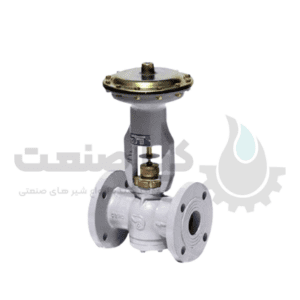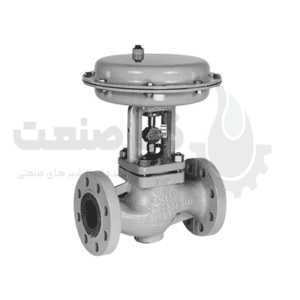
Your cart is empty!
Showing all 2 results
 برای سفارش و اطلاع از قیمت با ما تماس بگیرید
برای سفارش و اطلاع از قیمت با ما تماس بگیرید
 برای سفارش و اطلاع از قیمت با ما تماس بگیرید
برای سفارش و اطلاع از قیمت با ما تماس بگیرید
The main function of a pneumatic valve, also known as a directional control valve, is to change the flow of air.
[read more]
What is a pneumatic valve?
These valves can keep the pressure constant. There are many categories of pneumatic valves and a wide range of pneumatic valves.
Pneumatic valves are classified based on their style, type, design principle, type of operation, performance, size and application.
A pneumatic valve can do everything from turning a single flow path on and off to proportional control of pressure and flow.
Most pneumatic valves have a control function, which can be defined as the operation of the valve in any process or the control of a quantity.
A control function requires control energy which can be determined by the actuation mode which can be manual, mechanical, hydraulic or pneumatic.
Pneumatics is the use of pressurized air for mechanical movement.
Pneumatics is also used in control valves and has many applications in various industries. Other applications include dentistry, construction and mining. Air is the fuel of pneumatic power.
Pneumatic control valves can reduce the pressure in a controlled manner using actuators and positioners controlled by the controller.
Controllers can detect pressure fluctuations and adjust the air supply signal to the pneumatic positioner.
A pneumatic positioner delivers air to the diaphragm and allows a valve to open.
Springs are used as an opposing force, causing the valves to close as the air pressure applied to the diaphragm is lost or reduced. Many industries rely on pneumatic control valves.

Pneumatic valves, also known as directional control valves, can be configured in a number of ways, including:
with the number of flow paths or switching positions that are possible
with the number of input and output ports they have
With the mechanism used to open or close the ports
According to the status of the valve when not activating it
Directional control valves that control the direction of air flow or completely prevent it are a large class of pneumatic valves with many types.
These devices can be used in a hydraulic system to connect or disconnect the system’s main source of compressed air or to advance or retract air cylinders that are part of the machine or process for which the pneumatic system is designed.
The two ports are connected by a passage that can be opened or closed to control the flow through the valve.
An electrically actuated solenoid valve typically switches a spool or pop valve to direct flow.
Many systems use the simple on and off function of a valve to lock, isolate and connect different parts of the system.
Three-way and two-way valves consist of three ports that are connected by passages inside the valve body.
To control a single-acting cylinder or pilot another valve, valves pressurize and depressurize an outlet port.
Three-way valves direct pressurized air to the end of the cylinder head.
Moving the spool to the opposite side prevents the current and pressure from reaching the actuator.
Since the actuator is attached to the exhaust duct, gravity or a spring must return the rod to its original position.
Three-way valves can also be used in pairs to control a two-way cylinder, effectively replacing a four-way valve.
When high cylinder speed is required, use paired three-way valves instead of four-way valves.
Connecting the three-way valves close to the cylinder ports reduces cylinder back pressure and pressure drop in the lines, allowing for higher cylinder speeds.
In high cycle applications or when intermediate positions are required, valves are also used to conserve compressed air.
Two-way and four-way valves usually have four or five ports and two or three positions.
In each position, a two-position valve has two separate flow paths for actuating and reversing cylinders, rotary actuators, or bidirectional motors.
At the same time, the spool directs the flow through the pressure port and the other actuator port directs the exhaust to the atmosphere.
The four-way valve in the five-port, two-position version has five separate ports that offer different valve configurations, such as two exhaust ports or different pressures.
For example, in the latter case, the valve may exert a high pressure to actuate a cylinder and create a high clamping force, but a lower pressure (from a regulator) to release the clamp. Reducing pressure saves energy.
Five-port versions of four-way and three-position valves are also available.
The most common center conditions for these valves are “all ports blocked” and “exhaust center”.
The two extreme positions that control actuator movement are the four-port and four-way valve power positions.
The center position is intended to meet some system requirements, such as locking or allowing a floating actuator.
The way to change the direction of the air flow is called this type of classification of pneumatic valves.
For example, a two-way directional valve is either open (airflow is active) or closed. An actuator moves a valve spool into position to open or close each port.
The spring is used to release the valve spool and return the pneumatic valve to its original position.
Spring offset valve is a two-way directional valve that works like this.

Pneumatic valves can be classified based on the type of actuator they use.
They can be equipped with electromagnetic (electrical), air or mechanical actuators.
Solenoid valve
Solenoid valves respond to an electrical signal by opening and closing.
They regulate air flow in the pneumatic system and liquid flow in the hydraulic system. A spool valve or poppet arrangement is available.
Solenoid valves are commonly used in manufacturing environments. This is because milk needs a constant temperature to function properly.
From a design point of view, air valves are like solenoid valves. They do not respond to an electrical signal, but to air pressure by applying force to a piston or diaphragm.
Vented valves are found in environments that require high output, but valves that do not rely on electricity and are instead operated remotely.
As a result, they are used in chemical factories and fertilizer production facilities.
When chemicals are exposed to the wrong materials, they can cause combustion and endanger their operators. People are kept away from potentially toxic nitrogen compounds in the latter.
Mechanical valves, also known as manual valves, are manually controlled.
They may be seen in situations where electricity is dangerous or impractical for the task at hand.
Like solenoid valves, they can be used for both air flow and liquid flow.
Typically, these valves are moved by applying energy with hands or feet.
It is necessary to move a push lever or press a button by the operator.
Mechanical valves now have to be larger in size to accommodate higher flow rates.
A pneumatic valve, also known as a directional control valve, directs or blocks the flow of compressed air or other gases in a system.
These valves act as guides for other valves and act as actuators for other components such as actuators, clamps, hand tools or other devices.
A 2/3-way valve has three ports and two settings and can be operated pneumatically, manually, mechanically or electrically via a solenoid valve.
They can be used to adjust a single-acting cylinder, pneumatic actuators, blowing, pressure release, or in vacuum applications.
Pneumatic systems are designed to transmit and control energy using compressed air.
Pneumatic systems are found in production lines, train doors and mechanical clamps.
Many industrial companies are unable to operate without specialized use of pneumatic control systems. Pneumatics is often the driving force of automatic machines.
Among the advantages of using these devices, the following can be mentioned:
Compressed air systems never run out of air because there is an infinite amount in our atmosphere that can be used to supply compressed air.
Compressed air can be easily transported through pipes and is not limited by distance.
When compressed air is discharged back into the atmosphere, it does not need to be recycled or processed.
The tools are durable and reliable.
Compared to other electromotor elements, the components of these machines, such as pneumatic valves, are not easily damaged.
These devices are completely safe to use.
Compared to electromotor systems, pneumatic systems are generally the safer of the two types.
This is because pneumatic systems do not produce sparks or explosions, which means they can work in combustible environments.
Compared to an electromotor component, pneumatic systems do not overheat or burn out when overloaded.
Today, pneumatic valves are an integral part of industries, which are available in different models and brands in the market.
شما می توانید انواع شیرهای پنوماتیک را با ضمانت نامه 18 ماهه از کیاصنعت تهیه نمایید.
[/read]Copied to clipboard